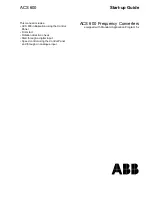
Section 2: Installation of the frequency converter
2.4. Connection of control systems
Fig. 2.4 shows a view of terminal blocks of the frequency converter control
block together with a simplified internal block diagram. Tables 2.3 and 2.4 de-
scribe the functions of the individual terminals.
Figure 2.4. View of control system terminal blocks (X1, X2) and an exemplary connec-
tion configuration
Table 2.3. Control terminal block X1 – inputs and outputs
No
Name
Description
Note
X1:1
B
Interface RS-485, line B
Terminator/bias are connected
with J25/J26 jumpers
X1:2
A
Interface RS-485, line A
The same
X1:3
AGND
Analog Ground
Use only for connecting analog
inputs/outputs signals
X1:4
AO1
Analog Output 1 (current
mode)
X1:5
AGND
Analog Ground
Use only for connecting analog
inputs/outputs signals
X1:6
AI1
Analog input 1 (voltage
mode)
Input impedance:
470 kOhm
X1:7
AI2
Analog input 2 (current
mode)
Input impedance:
= 500 Ohm
TWERD Power Electronics
17
16
15
14
13
12
11
10
9
8
7
6
5
4
3
2
1
A
B
A
O
1
+
10
V
A
G
N
D
A
G
N
D
A
I1
A
I2
G
N
D
D
I6
D
I5
D
I4
D
I3
D
I2
D
I1
+
24
V
X1
Modbus
master
RS-485
P
–
I
6
5
4
3
2
1
K1, K2 - relay outputs.
Can be used e.g. to control signal
lights at 230 V
A
NO
K2
K1
NC
C
O
M
X2
NO
NC
C
O
M
X2
J26 J25
Terminal jumpers of RS-485 interface.
J25 and J26 should be closed when
the frequency converter is the last
device on the communication line.
X1
Analog inputs:
AI1 – voltage
AI2 – current
Current
analog
output
AO1
RS-485
Digital inputs DI1..DI6
U –/~
Passive current
source
Input
+24V
Output
An example of connecting the
equipment with a passive
current source to the AI2 input
+
















































